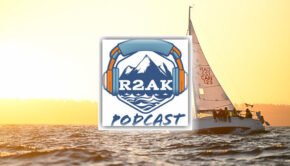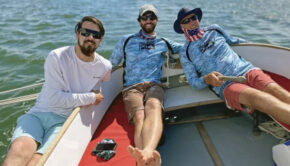Race to Alaska: Hubris, Irony, and the Inside Passage
Published on June 20th, 2016
The Race to Alaska (R2K) is a unique 750-mile marathon open to all forms of non-motorized craft. Entrants can have no support of any type; it’s like the Iditarod but on a boat. Avoid drowning, freighters, killer whales, and grizzly bears, and the winner gets $10,000. A set of steak knives awaits the runner-up.
The race, from Port Townsend (WA) to Ketchikan (AK), survived its inaugural edition in 2015. Testing fate, it occurs again this month. Scuttlebutt editor checks in Jake Beattie, who is the Executive Director of race host Northwest Maritime Center…
How do you rate the first edition?
Definitely a success. Just by the simple fact that we didn’t go broke and nobody died. We felt like we knocked it out of the park!
More seriously, when we announced the first race back in 2014, we honestly thought it might just end up being ten of our friends. We ‘d send them to Alaska, they’d hoot and holler when they got there, and the outside awareness would be minimal. We were so wrong. National press, a thousand or so people came out to watch the 5:00 am start… just the fact that we had 35 teams in the first place… it all took us by surprise and blew us away.
We never got to sign anyone’s cleavage but we got fan mail at least once a day during the race. We’ve never gotten fan mail before. It was pretty cool. The best part wasn’t the attention for attention’s sake, but that people seemed to be connecting to the founding reasons for why we started the R2AK in the first place, which was to motivate regular folks into adventure and to celebrate both the impressive feats by incredible mariners, but perhaps more importantly, the triumphs and failures of those “everyday heroes”.
From the 2015 race came great stories of impressive seamanship, hot shit sailing, self-reliance when things went wrong, and unbridled humanity. Better yet, a lot of those moments were by people who could just live down the street. We were able to give a voice to those folks, and just the fact that people cared would have made it a success in my book.
 Any key takeaways last year?
Any key takeaways last year?
From a race perspective, I think the biggest thing we took away was that it felt like we were on to something, that for some reason this Race to Alaska tapped into a vein of human spirit that the adventure/sailing world had been waiting for a long time.
We started with an idea that felt right, and later we were able to distill it into something that gets as close to the ethos of the race without sounding too official: Simple is harder, harder is better, people can take it, and there is hero in everyone. Sounds cheesy, but that and an ability to laugh at ourselves and everyone in the race feels like the secret sauce… until it all changes this year, and I look pretty foolish offering up platitudes.
And the feedback from the competitors?
We greeted every team that finished in Ketchikan, gave them some beer and just started listening. Each one of them had their battle stories, each one had a different take away, but the one that seemed to play through the fleet from the elite racers to the folks who used this race as an excuse to check off an item on their bucket list: this race is harder than the miles convey.
Last year, the fleet was tortured with weather that conventional wisdom said would be light but blew a gale on the nose for a week. That, coupled with tidal currents a lot of racers from out of the area aren’t used to, and racing that can go 24 hours day if the teams want it to, it opened a lot of people’s eyes pretty wide.
It’s a rough, beautiful, wild coast – nature is still pretty fresh here, and there’s not a lot of places to pull over and get help. More than a few team members looked different at the finish line than they did at the start – a combo of exhausted, humbled, satisfied.
What were the numbers last year?
There were 38 entries accepted into the race, 35 made it across the starting line, and 15 made it to Ketchikan.
We heard of breakdowns but no fatal encounters with bears or whales. Was that a cover-up?
Allegedly there is still an investigation of a Harken block found in a pile of bear scat. It’s our policy not to comment on ongoing investigations, even if we just made them up.
Any changes to the 2016 format?
After last year’s race, we took about a month to debrief, look at all of the things that went right, went wrong, and how it all played out. In that month, the rumors flew so we declared that we’d unveil all of the rule changes at a ticketed event at the Port Townsend Wooden Boat Festival (the Northwest Maritime Center’s other big event) the weekend after Labor Day. It was a sold out event and we unveiled…no rule changes. We just shifted the starting date a couple weeks back so as to not be on top of another big regatta we do in June.
How’s the entry count for 2016?
It’s a two stage race, with a 40 mile qualifier to Victoria and then part two goes all the way to Ketchikan. We’ve got 44 going the whole way to Alaska and another 19 that will only be trying to get to Victoria. The starting line is going to be goofy: the smallest boat is a 6-foot sailing robot. There are rowboats, canoes, kayaks, a guy on a paddleboard, a fleet of farriers, solo-rowing trimarans, a couple of monohulls, and a windsurfer. Same race, no handicaps – everyone has a different theory and we welcome all kinds – and they’re coming from around the world.
How does the 2016 field compare to the 2015 fleet?
Last year we had a spectrum of entrants. This included teams of great sailors on fast boats who were trying to win, people who were using the race as their tipping point reason for going to Alaska on their boat, and there were more than a few folks in the middle who weren’t the most highly trained sailors but thought they had discovered the boat that would hack the race course.
For those that thought their ingenuity could outpace boat speed, they suffered because of the strong winds. The 2015 race was all sail and fast boats did pretty well.
This year our fast boats are getting faster, and there are just as many if not more of the life list folks, but there are less people who think that they can go from the couch to a win. We kind of have two fleets in a way.
Have people narrowed in on the type of boat that can succeed?
We measure success a bit differently here, so… no? I mean, faster boats are definitely lining up for the prize money (and the steak knives), but there are just as many cool designs that are coming out to race like hell and push themselves uphill through bear-infested waters. There’s even a guy on a SUP who is trying to make it. His success factor is on another dimension than some of the serious race teams.
If there is one change this year to last is that there are less new builds this year. I can only think of one really – a cool solo trimaran with a pedal powered rig that was designed and built over the last year around the capabilities of the ex-pro cyclist who will be racing
What do you expect from the 2016 race?
Great seamanship, close calls, epic adventure, and zero bear deaths (fingers crossed).
If there is anything that last year’s race showed was that we should expect surprises. Last year was a race of attrition, but we only gave people a year from announcement to starting gun so there was a bit of a race just to get boats ready. This year we have some teams who have been preparing for this race for 2 years, and a couple of the teams that exited early last year have re-entered this year, so my hunch is that we will have less catastrophic failures…but who knows.
Hubris, irony, and the Inside Passage were a pretty powerful trio in last year’s race, and some of the favorites going in only made it 24 hours. This time of year is a transitional time for the coast’s weather, so this year’s race could be faster or boring depending on what systems are moving through. Hell, if that Pacific High forms early it could be a rowing race. The randomness of this race is one of the R2AK’s equalizers, and it’s a big part of its charm…at least for me. HA!
——————-
Background:
Stage 1: Port Townsend, WA to Victoria BC (40 miles)
It all begins June 23 with an initial race across open water, two sets of shipping lanes, and an international border. The first stage is designed as a qualifier for the full race and as a stand-alone 40 mile sprint for people who just want to put their toe in. Racers continuing on will clear Canadian customs in Victoria. Stage one winners get to bask in the glory for a full day and a half.
Stage 2: Victoria BC to Ketchikan, AK (710 miles)
There’s no time splits from the qualifier that roll over when the fleet starts in Victoria on June 26. The race for the prizes – real or imagined – is getting to Ketchikan. For those that lag, they risk getting tapped out by the sweep boat which heads north along the course as a rolling disqualifier. Any competitor the sweep boat passes is out of the race. Other than two waypoints at Seymour Narrows and Bella Bella, there is no official course. To quote the bard: You can go your own way.
Winner: The 2015 race was won by Team Elsie Piddock – Al Hughes, Graeme Esarey, and Matt Steverson – that crushed the fleet in a F-25c, completing Stage 2 in 5 days, 1 hour, 55 minutes. They finished almost 40 hours ahead of the second place finisher Team MOB Mentality (F85SR, a 28′ Farrier “Super Racer”) which just edged by 4 minutes third place finisher Team Por Favor (Hobie 33).







 We’ll keep your information safe.
We’ll keep your information safe.